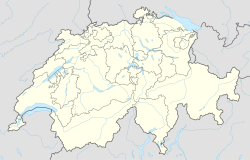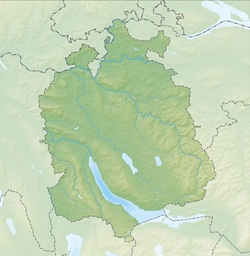Wangen-Brüttisellen
| Wangen-Brüttisellen | ||
|---|---|---|
 |
||
|
||
| Coordinates: 47°25′N 8°39′E / 47.417°N 8.650°ECoordinates: 47°25′N 8°39′E / 47.417°N 8.650°E | ||
| Country | Switzerland | |
| Canton | Zurich | |
| District | Uster | |
| Area | ||
| • Total | 7.92 km2 (3.06 sq mi) | |
| Elevation | 465 m (1,526 ft) | |
| Population (Dec 2016) | ||
| • Total | 7,874 | |
| • Density | 990/km2 (2,600/sq mi) | |
| Postal code | 8602 Wangen, 8306 Brüttisellen | |
| SFOS number | 0200 | |
| Surrounded by | Bassersdorf, Dietlikon, Dübendorf, Lindau, Volketswil | |
| Website |
www SFSO statistics |
|
Wangen-Brüttisellen is a municipality in the district of Uster in the canton of Zürich in Switzerland, located in the Glatt Valley (German: Glattal).
Wangen-Brüttisellen now incorporates Wangen bei Dübendorf, which was at one time a separate town. The photo used on this page is the center of what once was known as Wangen bei Dübendorf.
Wangen-Brüttisellen has an area of 7.9 km2 (3.1 sq mi). Of this area, 46.6% is used for agricultural purposes, while 26.7% is forested. Of the rest of the land, 26.4% is settled (buildings or roads) and the remainder (0.3%) is non-productive (rivers, glaciers or mountains). In 1996[update] housing and buildings made up 13.3% of the total area, while transportation infrastructure made up the rest (13%). Of the total unproductive area, water (streams and lakes) made up 0.3% of the area. As of 2007[update] 21.6% of the total municipal area was undergoing some type of construction.
Wangen-Brüttisellen has a population (as of 31 December 2016) of 7,874. As of 2007[update], 24.3% of the population was made up of foreign nationals. As of 2008[update] the gender distribution of the population was 50.5% male and 49.5% female. Over the last 10 years the population has grown at a rate of 30%. Most of the population (as of 2000[update]) speaks German (81.5%), with Italian being second most common ( 5.3%) and Albanian being third ( 2.8%).
In the 2007 election the most popular party was the SVP which received 44% of the vote. The next three most popular parties were the SPS (15.3%), the FDP (13.4%) and the CSP (10.2%).
...
Wikipedia




